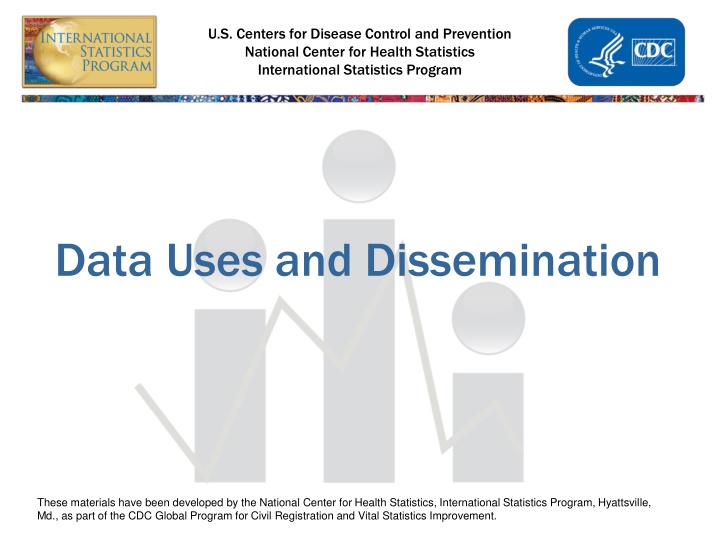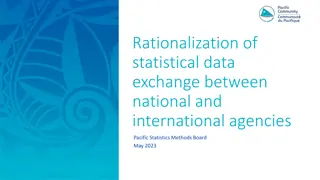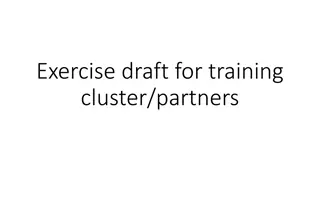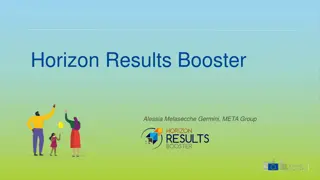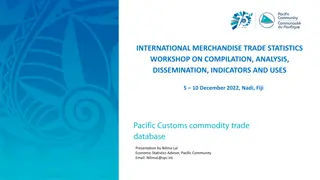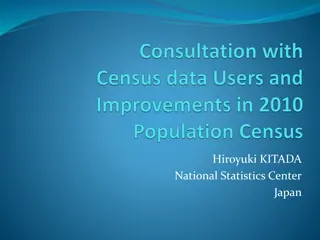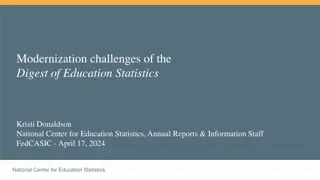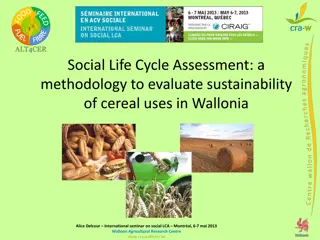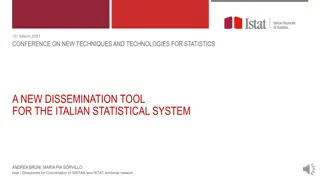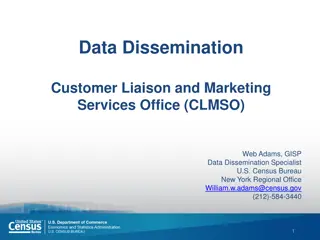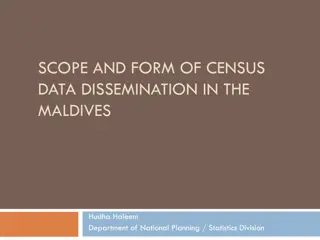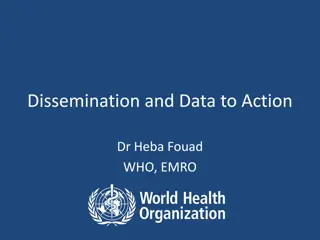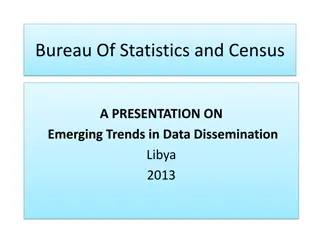Data Uses and Dissemination
Centers for Disease Control and Prevention's National Center for Health Statistics, International Statistics Program in Hyattsville, Md., has developed these materials.
Download Presentation

Please find below an Image/Link to download the presentation.
The content on the website is provided AS IS for your information and personal use only. It may not be sold, licensed, or shared on other websites without obtaining consent from the author.If you encounter any issues during the download, it is possible that the publisher has removed the file from their server.
You are allowed to download the files provided on this website for personal or commercial use, subject to the condition that they are used lawfully. All files are the property of their respective owners.
The content on the website is provided AS IS for your information and personal use only. It may not be sold, licensed, or shared on other websites without obtaining consent from the author.
E N D
Presentation Transcript
U.S. Centers for Disease Control and Prevention National Center for Health Statistics International Statistics Program Data Uses and Dissemination These materials have been developed by the National Center for Health Statistics, International Statistics Program, Hyattsville, Md., as part of the CDC Global Program for Civil Registration and Vital Statistics Improvement.
Outline Using vital statistics Publications Electronic media/internet Special uses of data Professional/technical meetings International comparisons 2 Data Uses and Dissemination
NOTE Goal of presentation: to explain how vital statistics processes should work Information may not be directly relevant to your work, but you can: Use the information to evaluate available CRVS data Advocate for improvements to CRVS system Apply the information in own work setting (i.e. local area or hospital) 3 Data Uses and Dissemination
Using Vital Statistics United Nations minimal goals: 1) Total monthly or quarterly summary counts prompt enough to provide info for administrative or other needs 2) Detailed annual tabulations for vital events cross classified by demographic and socioeconomic characteristics 4 Data Uses and Dissemination SOURCES: PRVSS2, Chapter II.D.4; NCHS, 15:6.
Using Vital Statistics Central agency needs to: Identify and assess needs of users Understand problems of VS suppliers & users Make sure VS suppliers & users understand their obligations and constraints Disseminate VS information widely Alternative: make micro-level data available to outside users/researchers 5 Data Uses and Dissemination SOURCES: PRVSS2, Chapter II.D.4; NCHS, 15:6.
Publications Annual data Time trends Geographical differentials Frequency distributions of vital events, including: Causes of death tabulations Leading cause of death lists Include delayed & late registration by year of occurrence 6 SOURCE: PRVSS2, Chapter II.I.1-2; UN Handbook, Module 19, A; NCHS, Unit 17. Data Uses and Dissemination
Publications Major sections Preface & letter of transmittal Table of contents & lists of tables and figures Introductory & explanatory notes Summary highlights Mid-year population estimates (data used in computations) Statistics: natality & mortality (marriage & divorce) Annex / appendix 7 Background table of contents from Statistics South Africa Mortality Report, 2008 SOURCE: PRVSS2, Chapter II.I.1-2; UN Handbook, Module 19, A; NCHS, Unit 17. Data Uses and Dissemination
Publications Include in annex / appendix: Details of national tabulation program Outlines of essential tables Technical notes & definitions Statistics South Africa, Mortality Report, 2008 Confidence interval calculation / table 8 SOURCE: PRVSS2, Chapter II.I.1-2; UN Handbook, Module 19, A; NCHS, Unit 17; NVSS Births, p 96-100. Data Uses and Dissemination
Publications Available on a regular & timely basis Printed report Ad hoc tabulations CDs, diskettes, online, other media Conform to a designed plan to meet user needs Part of a series Easily identifiable for filing and reference in libraries 9 SOURCE: PRVSS2, Chapter II.I.1-2; UN Handbook, Module 19, A; NCHS, Unit 17. Data Uses and Dissemination
Publications Printed reports Clear formatting Tables with supporting text Annotations on data limitations Analysis of meaning of data Calculation of vital rates Figures, maps, graphs for important points Confidence intervals 10 SOURCE: PRVSS2, Chapter II.I.1; NCHS, Unit 17. Data Uses and Dissemination
Discuss What items might go into the technical appendices of a printed annual report? 11 Data Uses and Dissemination
Publications Electronic report Follow guidelines for printed reports Prominently display instructions for use of electronic material Brochure with summary highlights Sufficient for many users Can cut down on printing & distribution costs 12 SOURCES: UN, PRVSS2, 2010, Chapter II.I.1; UN, Handbook on Training in CRVSS, Module 19, A Data Uses and Dissemination
Publications: Monthly/Quarterly Bulletins Extensive cross-classification not necessary Alerts of unusual changes in vital events (epi surveillance) Quality control tool to identify missing/ miscoded data Targeted distribution to those with need for provisional information 13 SOURCE: PRVSS2, Chapter II.I.3, 7, Chapter II.I.2; UN Handbook, Module 19, B; NCHS, Unit 17. Data Uses and Dissemination
Publications: Monthly/Quarterly Bulletins May use a systematic sample of records for preliminary tabulations (final tabulations should include all records) By place of occurrence faster than usual residence By date of registration faster than date of occurrence Allows calculation of 12-month moving average Drop oldest month s frequency Replace with value of most recent month 14 SOURCE: PRVSS2, Chapter II.I.3, 7, Chapter II.I.2; UN Handbook, Module 19, B; NCHS, Unit 17. Data Uses and Dissemination
Publications in [Country] Slide to describe the types of vital statistics publications that are produced in the country. 15 Data Uses and Dissemination
Discuss What are some advantages and disadvantages of utilizing sampling rather than all records in preparing vital statistics reports? 16 Data Uses and Dissemination
Publications: Directory of Users Efficient & targeted dissemination of reports Track publication users and dissemination activities Record names, addresses, fax numbers, email addresses, & products of interest (i.e. monthly report) Update regularly SOURCE: PRVSS2, Chapter II.I.3, 7, Chapter II.I.2; UN Handbook, Module 19, B, F. 17 Data Uses and Dissemination
Publications: Directory of Users For announcing release of products & meetings Separate by publication type General distribution list can include: Demographic & other research centers Major libraries Health, education, planning ministries Commercial users Vital statistics offices of selected countries International agencies 18 Data Uses and Dissemination SOURCE: NCHS, Unit 17.
Review: Publications Annual data Major sections Availability Design plan Printed & electronic reports Monthly/quarterly bulletins Directory of users 19 Data Uses and Dissemination
Discuss What factors would you consider in determining the contents of vital statistics reports? 20 Data Uses and Dissemination
Electronic Media/Internet Public use data Data tapes, disks, downloadable internet files For purchase or free Contain de-identified data to protect privacy Publicize availability of data Used to update local population databases Planning Evaluating Monitoring 21 SOURCES: PRVSS2, Chapter II.I.4-5; UN Handbook, Module 19, A-B. Data Uses and Dissemination
Special Uses of Data: Special Files for Research Public use data Availability of original datasets Without corrections (editing and imputations) Need documentation of changes made With/without identifiers (need approval for identifiable data) Administrative procedures for requests, guarantees of confidentiality 22 SOURCE: PRVSS2, Chapter II.I.4-5; UN Handbook, Module 19, A,B; NCHS, Unit 17; Freedman, p 8. Data Uses and Dissemination
Special Uses of Data: Special Files for Research Special tabulations on request Examples: Small area data analysis Sample data analysis Analysis of VS data matched to another source Helpful to offer analytic consulting Recommendations on use & interpretation of data, including confidence intervals 23 SOURCE: PRVSS2, Chapter II.I.4-5; UN Handbook, Module 19, D. Data Uses and Dissemination
Special Uses of Data: Information for Non-health Uses Potential Users Police Social security Economic planning Population projections Sampling frame for various projects Worker s insurance School planning Considerations for data use Terms of use Limitations of data 24 Data Uses and Dissemination SOURCE: NCHS, Unit 17.
Review: Special Uses of Data Research Public use data Original data sets Special tabulations Non-health data users 25 Data Uses and Dissemination
Special Uses of Vital Statistics Data in [COUNTRY] If applicable, list special uses of vital statistics data in [country]. 26 Data Uses and Dissemination
Discuss How would you disseminate vital statistics to the general public? How and to whom would you distribute the vital statistics reports? 27 Data Uses and Dissemination
Professional/Technical Meetings Good communication with data users is essential, especially for: Data released in electronic format Special tabulations Periodic meetings to discuss data with users Content of data files Limitations of data Best uses of data 28 Data Uses and Dissemination SOURCE: PRVSS2, Chapter II.I.6; UN Handbook, Module 19, E, F; NCHS, 15:7.
Professional/Technical Meetings Reduce questions for office Help frequent users of vital statistics info Forum to solicit direct user input to stay attuned to needed changes Announce widely Address media needs 29 SOURCE: PRVSS2, Chapter II.I.6; UN Handbook, Module 19, E, F; NCHS, 15:7. Data Uses and Dissemination
Professional/Technical Meetings in [COUNTRY] List professional or technical meetings that are hosted in [COUNTRY] to help users better understand the country s vital statistics data. 30 Data Uses and Dissemination
Using Vital Statistics: International Comparisons Presentation & Interpretation Data Quality Consistency Presentation Methodology Explanation Coverage Underlying differentials Time period Choice of Countries Context Comparability 31 SOURCES: Australian Institute of Health and Welfare 2012. A working guide to international comparisons of health. Cat. No. PHE 159. Canberra: AIHW. Data Uses and Dissemination
Using Vital Statistics: International Comparisons Data Quality Consistency: Are the data defined consistently across countries? EXAMPLE: Enumeration of live births in OECD countries Include very premature babies Minimum gest. age = 12 weeks Minimum gest. age = 22 weeks and/or 500 grams birthwt. Czech Republic France the Netherlands Poland No minimum gest. age or birthweight Canada Japan Norway United States Norway Australia 32 SOURCES: Australian Institute of Health and Welfare 2012. A working guide to international comparisons of health. Cat. No. PHE 159. Canberra: AIHW. Data Uses and Dissemination
Using Vital Statistics: International Comparisons Data Quality Methodology: Do all countries use the same method to collect the data? Birth and death certificates/registries Mortality data National disease registries Hospital utilisation data Household surveys 33 SOURCES: Australian Institute of Health and Welfare 2012. A working guide to international comparisons of health. Cat. No. PHE 159. Canberra: AIHW. Data Uses and Dissemination
Using Vital Statistics: International Comparisons Data Quality Coverage: Do the data cover similar parts of the population? Legislation Geography Information systems Population surveys of broader population 34 SOURCES: Australian Institute of Health and Welfare 2012. A working guide to international comparisons of health. Cat. No. PHE 159. Canberra: AIHW. Data Uses and Dissemination
Using Vital Statistics: International Comparisons Data Quality Time period: Do the data refer to the same time period? Should cover approximate same year/range of years If comparable years not available: Clearly label years covered by each country May use latest available data May only use countries whose data meet a particular range (e.g. the last 5 years) 35 SOURCES: Australian Institute of Health and Welfare 2012. A working guide to international comparisons of health. Cat. No. PHE 159. Canberra: AIHW. Data Uses and Dissemination
Discuss Review the table comparing maternal mortality ratio across European countries. What issues with data quality are noted? 36 Source: EURO-PERISTAT Project, with SCPE, EUROCAT, EURONEOSTAT. European Perinatal Health Report. Data from 204. 2008. Available: www.europeristat.com (Table 6.1) Data Uses and Dissemination
Using Vital Statistics: International Comparisons Choice of Countries Comparability: Are countries sufficiently similar to support comparison? Economic status / income per capita Population size Geographical land mass Geographic proximity 37 SOURCES: Australian Institute of Health and Welfare 2012. A working guide to international comparisons of health. Cat. No. PHE 159. Canberra: AIHW. Data Uses and Dissemination
INTERNATIONAL COMPARISON OF COUNTRIES Asia-Pacific Countries Infant Mortality Rate, per 1,000 live births OECD Countries Infant Mortality Rate, per 1,000 live births 0 20 40 60 0 5 10 15 Finland Iceland Japan Japan Singapore Australia Luxembourg Slovenia Sweden Czech Republic Denmark Republic of New Zealand Brunei Estonia France Germany Ireland Malaysia Sri Lanka Thailand Italy China Netherlands Norway Portugal Australia Austria Belgium Greece Fiji Vietnam Solomon Islands Phillipines Indonesia SOURCE: The World Bank. Databank. Infant mortality rate. Estimates developed by the UN Inter-agency Group for Child Mortality Estimation (UNICEF, WHO, World Bank, UN DESA, UNPD). 2011 figures. (http://data.worldbank.org/indicat or/SP.DYN.IMRT.IN) Israel Korea, DPR Republic of Spain Switzerland United Kingdom Canada Hungary New Zealand Poland United States Slovak Republic Mongolia Laos Cambodia Bangladesh Nepal 38 Bhutan Papua New India Turkey Mexico Data Uses and Dissemination Pakistan
Using Vital Statistics: International Comparisons Presentation & Interpretation Presentation: Are the data presented appropriately? Can (and should) the data be ranked from best to worst? Is there agreement on which indicator is best? What size are the differences separating country ranks? Has the country s performance been considered independently of the international context? 39 SOURCES: Australian Institute of Health and Welfare 2012. A working guide to international comparisons of health. Cat. No. PHE 159. Canberra: AIHW. Data Uses and Dissemination
MATERNAL DEATHS PER 100,000 LIVE BIRTHS SOURCE: Australian Institute of Health and Welfare 2012. A working guide to international comparisons of health. Cat. No. PHE 159. Canberra: AIHW. 40 Data Uses and Dissemination
Using Vital Statistics: International Comparisons Presentation & Interpretation Explanation: Is the variation between countries adequately explained? Genetic Political Cultural Environmental Economic Focus on what differences are present rather than why the differences are present 41 SOURCES: Australian Institute of Health and Welfare 2012. A working guide to international comparisons of health. Cat. No. PHE 159. Canberra: AIHW. Data Uses and Dissemination
Using Vital Statistics: International Comparisons Presentation & Interpretation Underlying differentials: Are differences within countries considered? Cultural groups Administrative sectors Socioeconomic status & income Rural-urban divides Literacy levels 42 SOURCES: Australian Institute of Health and Welfare 2012. A working guide to international comparisons of health. Cat. No. PHE 159. Canberra: AIHW. Data Uses and Dissemination
LIFE EXPECTANCY AT BIRTH (YEARS) SOURCE: Australian Institute of Health and Welfare 2012. A working guide to international comparisons of health. Cat. No. PHE 159. Canberra: AIHW. 43 Data Uses and Dissemination
Using Vital Statistics: International Comparisons Presentation & Interpretation Context: Can the data be used ouside of the international comparison? Standardization of data for comparisons Methods and definitions may differ International comparisons Official country estimates 44 SOURCES: Australian Institute of Health and Welfare 2012. A working guide to international comparisons of health. Cat. No. PHE 159. Canberra: AIHW. Data Uses and Dissemination
Mortality Statistics for Australia Using Different Data Sources SOURCES: Australian Institute of Health and Welfare 2012. A working guide to international comparisons of health. Cat. No. PHE 159. Canberra: AIHW. International counts from WHO mortality database, by year death occurred; age standardized National counts by year of registration 45 Data Uses and Dissemination
Activity Data Comparison: See handout for activity details. Review the international comparison of Maternal Mortality Ratio Using the materials provided: A. Comment on the strengths and weaknesses of the information presented. B. What are the implications of these strengths and weaknesses on the interpretation of the results? C. What additional information about the data would you like to have? 46 Data Uses and Dissemination
References (Freedman) Freedman, MA. Improving Civil Registration and Vital Statistics. The World Bank. 2003. (NCHS) National Center for Health Statistics. Methods of Civil Registration: Modular Course of Instruction. (NVSS Births) National Vital Statistics Reports. Births: Final Data for 2006. 57(7). 7 Jan 2009. (PRVSS2) UN. Principles and Recommendations for a Vital Statistics System, Revision 2. New York. 2001. (UN Handbook) UN. Handbook on Training in Civil Registration and Vital Statistics Systems. Studies in Methods, Series F, No. 84. UN: New York. 2002. 47 Data Uses and Dissemination
Activity Table of Contents: In small groups, prepare the table of contents for an annual vital statistics report on the population of your country. Compare your list with the actual report and with the table of contents of other groups. Discuss the agreements and disagreements. 48 Data Uses and Dissemination
Activity Report Content: In small groups, review sample reports from various countries. Compare and discuss: Report content (statistics, tables, text, etc) Use characteristics for evaluating international comparisons Report style Appendices Share and compare your observations with the class. 49 Data Uses and Dissemination
Activity Vital Statistics Report Review: In small groups, review the annual report and answer the questions on the handout. Compare your answers with those of other groups. Discuss the agreements and disagreements. 50 Data Uses and Dissemination
